EXPO billboard project merges onto highways
September 12, 2016
For Chicago natives, advertisements on digital billboards are no surprise, but a new billboard project allows drivers a new way to view contemporary art.
OVERRIDE, unveiled Aug. 29, was created as a teaser for the fifth annual EXPO CHICAGO—a contemporary art exhibition starting Sept. 22 at 600 E. Grand Ave. OVERRIDE was produced in conjunction with the City of Chicago’s Department of Cultural Affairs and Special Events and will run until Sept. 29.
OVERRIDE features 15 national and international artists, including seven Chicago-based artists.
According to an Aug. 18 press release from EXPO CHICAGO, the project includes new art created exclusively for the billboards as well as existing pieces from international and national galleries.
“It’s that magic that happens when [people] see a piece of artwork in a place that clearly is not advertising,” said Tony Karman, president of EXPO CHICAGO.
Stephanie Brooks, a Chicago-based artist and OVERRIDE contributor, said the most interesting aspect of the project is the art’s relationship to advertisements and culture.
Brooks’ contributions, entitled “meaningful glance” and “deep breath,” feature text on an otherwise blank space.
“Untitled #3” by Tammy Rae Carland, a part of an exhibit developed in 2002, is also featured in the project. Carland said the work selected for the project allows audiences to project themselves onto the images of an empty bed and stage.
She added that the project is a platform for social commentary as well as artistic expression.
Representatives from DCASE were not available for comment as of press time.
Duncan MacKenzie, a professor in the Art & Art History Department, said Chicago has always strongly supported contemporary public art, pointing to Anish Kapoor’s “Cloud Gate”—commonly known as “The Bean” in Millennium Park—which attracts millions of visitors a year, as well as Pablo Picasso’s untitled work in the Daley Center.
“There is something super neat that can happen on an individual level in that [public] space where you happen upon something unexpected,” MacKenzie said. “[Public art is] there to force you to have a moment of ‘Why is it there and why is it happening to me?’”








